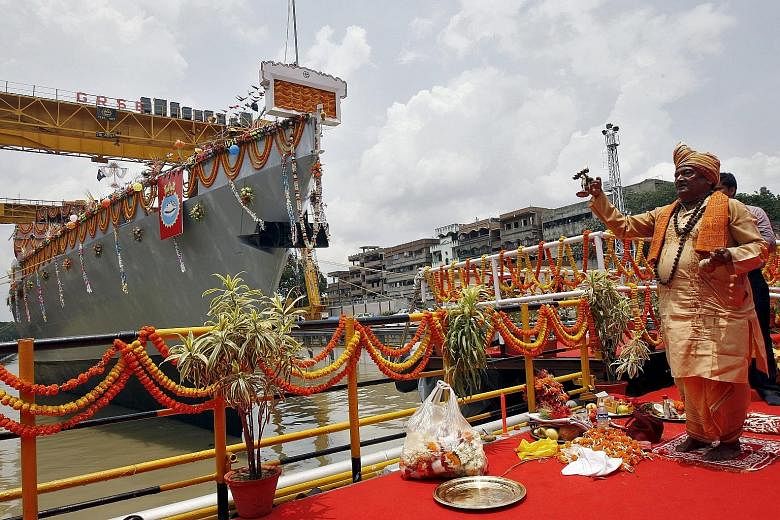NEW DELHI • In a dock near central Kolkata, one of India's most lethal new weapons is going through its final outfit.
The Kadmatt bristles with technology to sniff out and destroy underwater predators. It is the second of four warships in India's first dedicated anti-submarine force - a key part of plans to spend at least US$61 billion (S$83 billion) on expanding the navy's size by about half in 12 years.
The build-up is mostly aimed at deterring China from establishing a foothold in the Indian Ocean. Its other goal is to transform India's warship-building industry into an exporting force that can supply the region, including American partners in Asia wary of China's increased assertiveness.
The "naval build-up is certainly occurring in the context of India moving towards a greater alignment with the US and its allies to balance China", said Mr David Brewster, a specialist in Indo-Pacific security at the Australian National University in Canberra. "India wants to be able to demonstrate that Beijing's activities in South Asia do not come without a cost, and Delhi is also able to play in China's neighbourhood."
The US Seventh Fleet has patrolled Asia's waters since World War II and is backing India's naval expansion. On a January visit to New Delhi, US President Barack Obama pledged to explore ways of sharing aircraft carrier technology.
The two countries also flagged the need to safeguard security in the South China Sea, where neither has territorial claims.
India's fleet of 137 ships falls far short of the more than 300 vessels in China, which has Asia's biggest navy. China boasts at least 62 submarines, including four capable of firing nuclear ballistic missiles, according to the Pentagon.
"We would like to have the moon," Navy Vice-Chief P. Murugesan has said, acknowledging that India's goal of a 200-ship navy by 2027 was ambitious.
Most of the vessels will be made in India, a sign that moves to upgrade its shipyards are starting to pay off for the world's biggest importer of weapons. India plans to add at least 100 warships, including two aircraft carriers, and three nuclear-powered submarines capable of firing nuclear-tipped ballistic missiles. It will also tender for submarine-rescue vessels, a first for a navy that has operated submarines for four decades.
"What we are seeing is a significant ramping up of blue-water capacity," said Mr Collin Koh Swee Lean, an associate research fellow at the S. Rajaratnam School of International Studies in Singapore.
Part of that strategy involves overseas sales. India is boosting ties with Mauritius and Seychelles, and has offered to help Myanmar modernise its navy.
India is also hosting naval exercises with the US and Japan later this year and holding its first-ever drills with Australia in September.
Delhi wants to produce all of the components on its naval vessels domestically by 2030, Navy Chief R.K. Dhowan, has said. It now makes about a third of weapons and sensors, and about 60 per cent of propulsion systems.
To make that happen, Admiral Dhowan wants private firms involved. While India is capable of building warships, it relies on the US, Russia and Europe for technology and lags the world's bigger players, said researcher Siemon Wezeman at the Stockholm International Peace Research Institute.
"India does not have a very glorious record in defence manufacturing, and certainly not for exports," he said. "Things may change for the better with the private sector."
Chinese observers led by the Defence Ministry spokesman, Senior Colonel Yang Yujun, told Indian media this month that clashes are possible if India views the adjacent ocean as its "backyard".
"India wants to take a leadership role in the Indian Ocean and ultimately become the predominant naval power," Mr Brewster said. "Its moves reflect an instinctive view among many in Delhi that if the Indian Ocean is not actually India's Ocean, then in an ideal world it ought to be."
BLOOMBERG

